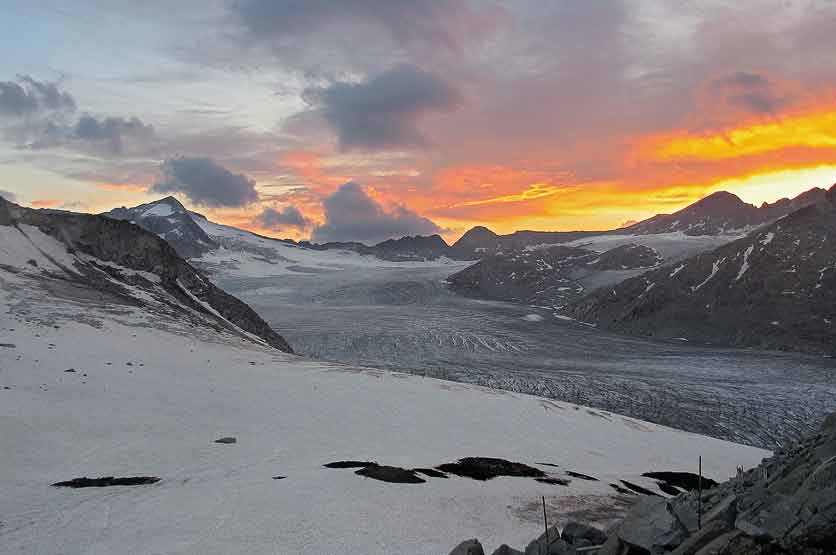 |
||||||
Dolomites and glaciersRoberto Bombarda
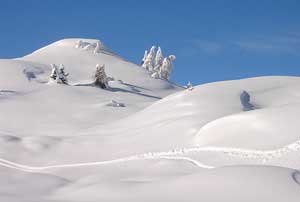 What would the mountains be without water in its various physical stages of liquid and gas? They would simply stop being what we see, climb and dream about every day. In all major mountain ranges, a large number of the most prominent mountains carry the trace of the purest form of water into their source. Snow and ice enter the scene in the leading role, from Everest -whose name in the original language of Tibet and Nepal evokes the presence of "eternal" snows- to Mont Blanc, ending with the Cima Tosa which rises high above the Brenta Dolomites. In the very place names of the Adamello-Brenta Natural Park's mountains, the three main geographic nodes (Brenta, Adamello and Presanella) all derive their names from the water. And the Dolomites owe their composition and shape to the water which has been home to their sediments, to the glaciers which have modelled their faces, to the rains and streams of water which have carved their slopes. What would the mountains be without water in its various physical stages of liquid and gas? They would simply stop being what we see, climb and dream about every day. In all major mountain ranges, a large number of the most prominent mountains carry the trace of the purest form of water into their source. Snow and ice enter the scene in the leading role, from Everest -whose name in the original language of Tibet and Nepal evokes the presence of "eternal" snows- to Mont Blanc, ending with the Cima Tosa which rises high above the Brenta Dolomites. In the very place names of the Adamello-Brenta Natural Park's mountains, the three main geographic nodes (Brenta, Adamello and Presanella) all derive their names from the water. And the Dolomites owe their composition and shape to the water which has been home to their sediments, to the glaciers which have modelled their faces, to the rains and streams of water which have carved their slopes.If it is not possible in our ideals to imagine a mountain without water or snow (after all, even as children we draw the mountain with a white peak and a blue stream running down its green slopes…) then it is sad to take stock of the current state of affairs. It is sad to see how climate change is affecting the natural environment and the mountain landscape through a reduction in precipitation; with a consequent fall in availability of water and reserves of incalculable value like glaciers and snowfields. 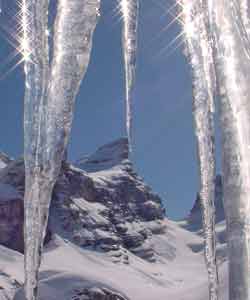 Abbot Stoppani wrote more than hundred years ago in "Bel Paese" (The Beautiful Country) that glaciers are "the most perfect natural measuring instruments" capable of recording even the tiniest variations in climate. And in fact it only needs a comparison of old pictures and early black and white photos with the current situation to realise how mountains -and the Dolomites are no different- are changing their appearance. But let us paraphrase the opening question. What would the Brenta Dolomites be without the snowy cap of Tosa; without the icy gulley which divides it from the imposing mass in the form of an overturned ship's bow at Crozzon; without the little "vedrette" (a word of Rhaetian origin which in the central Alps stands for "glacier") set in rings under the sharpest pinnacles running from the Sfulmini range to Tuckett and from the Agola to Prà Fiorì? In simple terms they would cease to be the Brenta Dolomites, or rather the Brenta which we have become acquainted with and learnt to love. When one speaks of alpine glaciers, one is usually led to discount the Dolomites range. Indeed, due to altimetric and orographic conditions (as well as lithographic ones, since the chalky Dolomite rocks, unlike granite, are largely permeable to water) these mountain ranges are not, shall we say, among the "most hospitable" for the life and development of a glacier. The glaciers of the Dolomites are therefore miracles of nature and survive at relatively low altitudes -often well below the limits for permanent snow. This is exclusively down to local reasons, such as their exposure to northern and western quadrants. Indeed, their protection is assured by having their great faces in the shadow as well as by accumulated avalanches offered by the surrounding peaks and a growing covering of debris. I am sure the reader can agree that the presence of ice and snow in a setting like the Dolomites (with the shapes and colours it is rich in), creates a truly stunning spectacle. Without fear of denial, I do not hesitate to classify the Brenta Dolomites range as the most beautiful of all the Dolomites precisely for this reason (although it is also the only Dolomites range which contains a length of more than forty kilometres with no interruption by roads and ski lifts …)! Other ranges in the Dolomites, though charming and noteworthy in their own right, do not hold up in comparison: the Marmolada has a large glacier, but just one; the Pale of San Martino, like Sella, Antelao, Civetta and other ranges still have a few small glaciers, but nothing to compare to the pearl necklace which decorates the western slope of Brenta and which until a decade ago haloed the entire mountain range. In fact, the eastern glaciers are now extinct and the only one exposed in the south, at Ambiez, has been substantially reduced in recent times. Abbot Stoppani wrote more than hundred years ago in "Bel Paese" (The Beautiful Country) that glaciers are "the most perfect natural measuring instruments" capable of recording even the tiniest variations in climate. And in fact it only needs a comparison of old pictures and early black and white photos with the current situation to realise how mountains -and the Dolomites are no different- are changing their appearance. But let us paraphrase the opening question. What would the Brenta Dolomites be without the snowy cap of Tosa; without the icy gulley which divides it from the imposing mass in the form of an overturned ship's bow at Crozzon; without the little "vedrette" (a word of Rhaetian origin which in the central Alps stands for "glacier") set in rings under the sharpest pinnacles running from the Sfulmini range to Tuckett and from the Agola to Prà Fiorì? In simple terms they would cease to be the Brenta Dolomites, or rather the Brenta which we have become acquainted with and learnt to love. When one speaks of alpine glaciers, one is usually led to discount the Dolomites range. Indeed, due to altimetric and orographic conditions (as well as lithographic ones, since the chalky Dolomite rocks, unlike granite, are largely permeable to water) these mountain ranges are not, shall we say, among the "most hospitable" for the life and development of a glacier. The glaciers of the Dolomites are therefore miracles of nature and survive at relatively low altitudes -often well below the limits for permanent snow. This is exclusively down to local reasons, such as their exposure to northern and western quadrants. Indeed, their protection is assured by having their great faces in the shadow as well as by accumulated avalanches offered by the surrounding peaks and a growing covering of debris. I am sure the reader can agree that the presence of ice and snow in a setting like the Dolomites (with the shapes and colours it is rich in), creates a truly stunning spectacle. Without fear of denial, I do not hesitate to classify the Brenta Dolomites range as the most beautiful of all the Dolomites precisely for this reason (although it is also the only Dolomites range which contains a length of more than forty kilometres with no interruption by roads and ski lifts …)! Other ranges in the Dolomites, though charming and noteworthy in their own right, do not hold up in comparison: the Marmolada has a large glacier, but just one; the Pale of San Martino, like Sella, Antelao, Civetta and other ranges still have a few small glaciers, but nothing to compare to the pearl necklace which decorates the western slope of Brenta and which until a decade ago haloed the entire mountain range. In fact, the eastern glaciers are now extinct and the only one exposed in the south, at Ambiez, has been substantially reduced in recent times.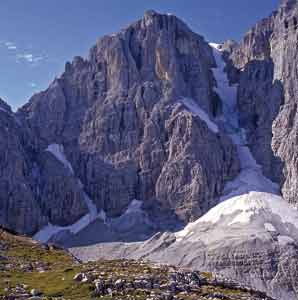 When John Ball (the first president of the Alpine Club of London) opened the eyes of the world to Brenta in 1864 with his "Riva to Pinzolo by the Bocca di Brenta", the most famous mountain pass in the range was covered by a thick blanket of snow and ice from one side to the other: today this has completely disappeared. Only the most snow-filled winters now allow us to conserve even a small field of snow on the Val Rendena side of the mountain during the increasingly sultry summers. The Austrian Julius Payer who was then a twenty year old, travelled the same passes to climb to Adamello (the first to do so). But he did not forget Brenta in his writings, just like other talented scientists, mountaineers and painters who described its features in the years that followed: these include Freshfield, Compton, Tuckett and Richter to name a few. We owe the first map representation of any precision (produced in 1888) to the last name mentioned in this list. We can infer from it the presence of no less than twenty glaciers (some were divided up in subsequent decades) over a surface area of 460 hectares. The annual glaciological campaigns began from 1895, the year in which the Italian Glaciological Committee was launched. They were completed by various operators and in the last twenty years have been underpinned by volunteers from Trentino belonging to the Glaciological Committee of SAT, with additional support from the Natural Park and the Province of Trento. We can draw out some firm details in quantifying the glacial presence in the Brenta Dolomites since 1888: 18 small glaciers were catalogued over a surface area of 322 hectares with the national cadastre of 1962; the technical map of the Deutscher Alpenverein (German Alpine Club) of 1988 also allows assessment of several "glacionevati" (small stationary glaciers) over a total surface area of 234 hectares; the cadastre completed by SAT on behalf of the Park in 1994 detected around 30 examples of glaciers and "glacionevati" (small stationary glaciers) over a surface area of around 180 hectares. The warmest of the last 150 years occurred between 1994 and 2007 (indeed, they were probably the warmest even of the last millennium and beyond) - amongst which the warmest of all was 2003. These were years of extreme warmth and scarce winter precipitation. Hence they were disastrous for all glaciers but especially for those of the Dolomites. The latest surveys by SAT help us today to quantify the presence of ice in the vicinity of about 100 hectares, which is less than one quarter of the level of 120 years ago! The broadest example in the Brenta is at Agola, followed by Prà Fiorì. While the latter has been subject to precise monitoring from 1990 onwards which provides evidence of its halving over that time period, the Agola since 2002 has become the "champion" glacier. More precisely, it is the one which research is centred on insofar as it is now considered the most representative of the entire group. By studying the balance of mass, we have been able to learn for example that this glacier has lost a good 20 metres of thickness in the frontal area in five years. This is an average reduction of around 2 metres annually and a loss between 2003 and 2006 of the equivalent of 1.6 million litres of water! When John Ball (the first president of the Alpine Club of London) opened the eyes of the world to Brenta in 1864 with his "Riva to Pinzolo by the Bocca di Brenta", the most famous mountain pass in the range was covered by a thick blanket of snow and ice from one side to the other: today this has completely disappeared. Only the most snow-filled winters now allow us to conserve even a small field of snow on the Val Rendena side of the mountain during the increasingly sultry summers. The Austrian Julius Payer who was then a twenty year old, travelled the same passes to climb to Adamello (the first to do so). But he did not forget Brenta in his writings, just like other talented scientists, mountaineers and painters who described its features in the years that followed: these include Freshfield, Compton, Tuckett and Richter to name a few. We owe the first map representation of any precision (produced in 1888) to the last name mentioned in this list. We can infer from it the presence of no less than twenty glaciers (some were divided up in subsequent decades) over a surface area of 460 hectares. The annual glaciological campaigns began from 1895, the year in which the Italian Glaciological Committee was launched. They were completed by various operators and in the last twenty years have been underpinned by volunteers from Trentino belonging to the Glaciological Committee of SAT, with additional support from the Natural Park and the Province of Trento. We can draw out some firm details in quantifying the glacial presence in the Brenta Dolomites since 1888: 18 small glaciers were catalogued over a surface area of 322 hectares with the national cadastre of 1962; the technical map of the Deutscher Alpenverein (German Alpine Club) of 1988 also allows assessment of several "glacionevati" (small stationary glaciers) over a total surface area of 234 hectares; the cadastre completed by SAT on behalf of the Park in 1994 detected around 30 examples of glaciers and "glacionevati" (small stationary glaciers) over a surface area of around 180 hectares. The warmest of the last 150 years occurred between 1994 and 2007 (indeed, they were probably the warmest even of the last millennium and beyond) - amongst which the warmest of all was 2003. These were years of extreme warmth and scarce winter precipitation. Hence they were disastrous for all glaciers but especially for those of the Dolomites. The latest surveys by SAT help us today to quantify the presence of ice in the vicinity of about 100 hectares, which is less than one quarter of the level of 120 years ago! The broadest example in the Brenta is at Agola, followed by Prà Fiorì. While the latter has been subject to precise monitoring from 1990 onwards which provides evidence of its halving over that time period, the Agola since 2002 has become the "champion" glacier. More precisely, it is the one which research is centred on insofar as it is now considered the most representative of the entire group. By studying the balance of mass, we have been able to learn for example that this glacier has lost a good 20 metres of thickness in the frontal area in five years. This is an average reduction of around 2 metres annually and a loss between 2003 and 2006 of the equivalent of 1.6 million litres of water! 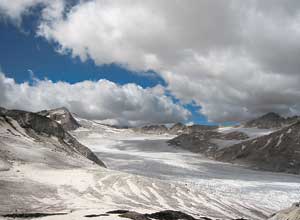 But the glaciers' reduction in volume and consequently in surface area goes well beyond affecting just the landscape and natural environment. Together with the local microclimate and ecosystem, the conditions for alpine pursuits are also impacted. Some paths become unfeasible or dangerous and the water supply to mountain retreats is also affected. All in all, by contributing in a decisive manner to changing the climate of the Earth, Man is also contributing to changing a part of the face of our mountains. If the trend of the last century were to continue, many scientists expect that within a few decades glaciers will disappear altogether from the Alps, starting from the Dolomites range itself. While obviously hoping that this forecast does not come true, we know that if this should now happen the Brenta Dolomites will never be the same again. We will certainly still love them -as will whoever follows us- but these mountains will no longer be the same as the ones we have become acquainted with. It is further warning that we must respect nature and one of its most precious gifts, water: doing this out of love for ourselves and future generations.
|
||||||
|
||||||